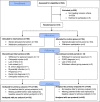Telemonitoring-Supported Exercise Training in Employees With Metabolic Syndrome Improves Liver Inflammation and Fibrosis
- PMID: 34140456
- PMCID: PMC8216678
- DOI: 10.14309/ctg.0000000000000371
Telemonitoring-Supported Exercise Training in Employees With Metabolic Syndrome Improves Liver Inflammation and Fibrosis
Abstract
Introduction: Metabolic syndrome (MetS) is a major health problem worldwide and the main risk factor for metabolic-associated fatty liver disease (MAFLD). Established treatment options are lifestyle interventions facilitating dietary change and increased physical activity. Here, we tested the effect of a telemonitoring-supported intervention on liver parameter of inflammation and fibrosis in individuals with MetS.
Methods: This was a prospective, randomized, parallel-group, and assessor-blind study performed in workers of the main Volkswagen factory (Wolfsburg, Germany). Volunteers with diagnosed MetS were randomly assigned (1:1) to a 6-month lifestyle intervention focusing on supervised, activity-tracker-guided exercise or to a waiting-list control group. This secondary analysis assessed the effect of the intervention on liver enzymes and MAFLD-related parameters.
Results: We screened 543 individuals between October 10, 2017, and February 27, 2018, of whom 314 were randomly assigned to the intervention group (n = 160) or control group (n = 154). Liver transaminases, alkaline phosphatase, and gamma-glutamyl transferase significantly decreased after 6 months in the intervention group compared with the CG. Furthermore, an aspartate aminotransferase-to-platelet ratio index score as a marker for liver fibrosis significantly decreased in the intervention group. These improvements were associated with changes in obesity and exercise capacity.
Discussion: A 6-month lifestyle intervention based on exercise training with individualized telemonitoring-based supervision led to improvements of liver inflammation and fibrosis in employees with MetS. Therefore, this intervention shows therapeutic potential for individuals at high risk of MAFLD (ClinicalTrials.gov Identifier: NCT03293264).
Copyright © 2021 The Author(s). Published by Wolters Kluwer Health, Inc. on behalf of The American College of Gastroenterology.
Conflict of interest statement
Figures





References
-
- O'Neill S, O'Driscoll L. Metabolic syndrome: A closer look at the growing epidemic and its associated pathologies. Obes Rev 2015;16(1):1–12. - PubMed
-
- Kanwar P, Kowdley KV. The metabolic syndrome and its influence on nonalcoholic steatohepatitis. Clin Liver Dis 2016;20(2):225–43. - PubMed
-
- Sherling DH, Perumareddi P, Hennekens CH. Metabolic syndrome. J Cardiovasc Pharmacol Ther 2017;22(4):365–7. - PubMed
-
- Eslam M, Sanyal AJ, George J, et al. . MAFLD: A consensus-driven proposed nomenclature for metabolic associated fatty liver disease. Gastroenterology 2020;158(7):1999–2014.e1991. - PubMed
-
- Younossi ZM, Rinella ME, Sanyal A, et al. . From NAFLD to MAFLD: Implications of a premature change in terminology. Hepatology 2021;73(3):1194–98. - PubMed
Publication types
MeSH terms
Associated data
LinkOut - more resources
Full Text Sources
Medical

